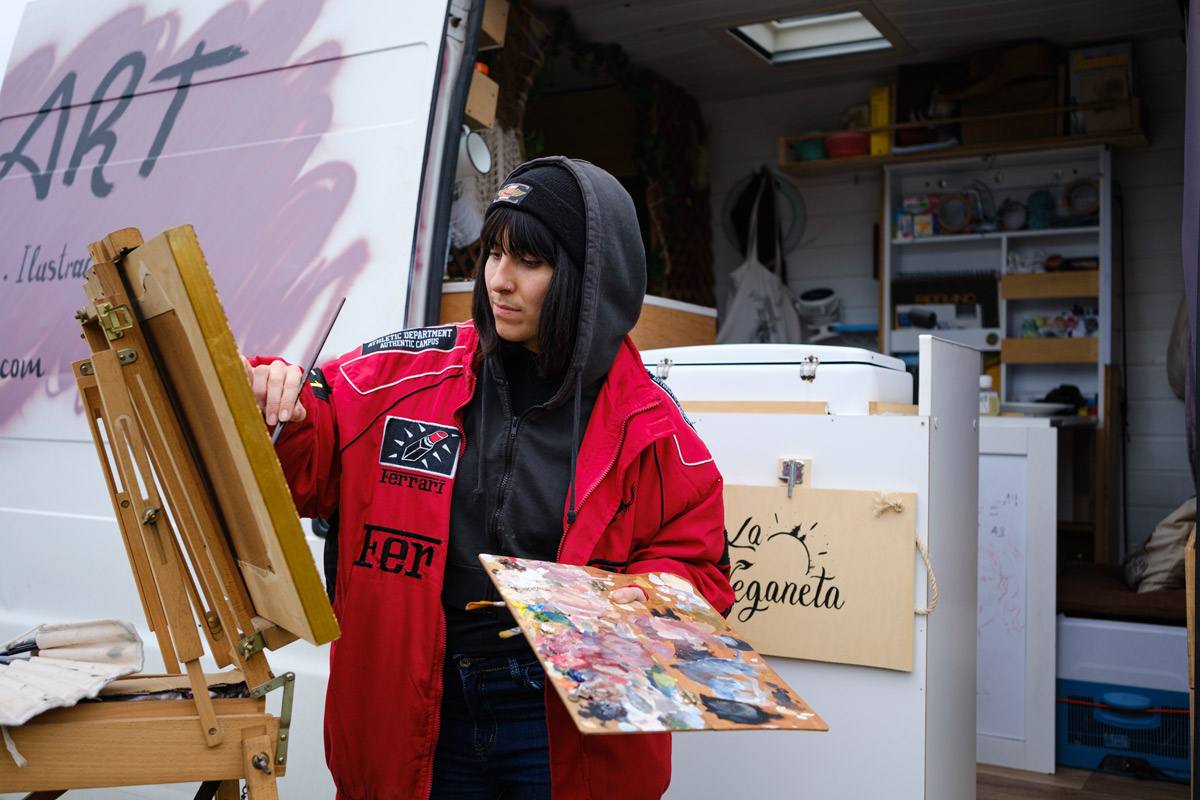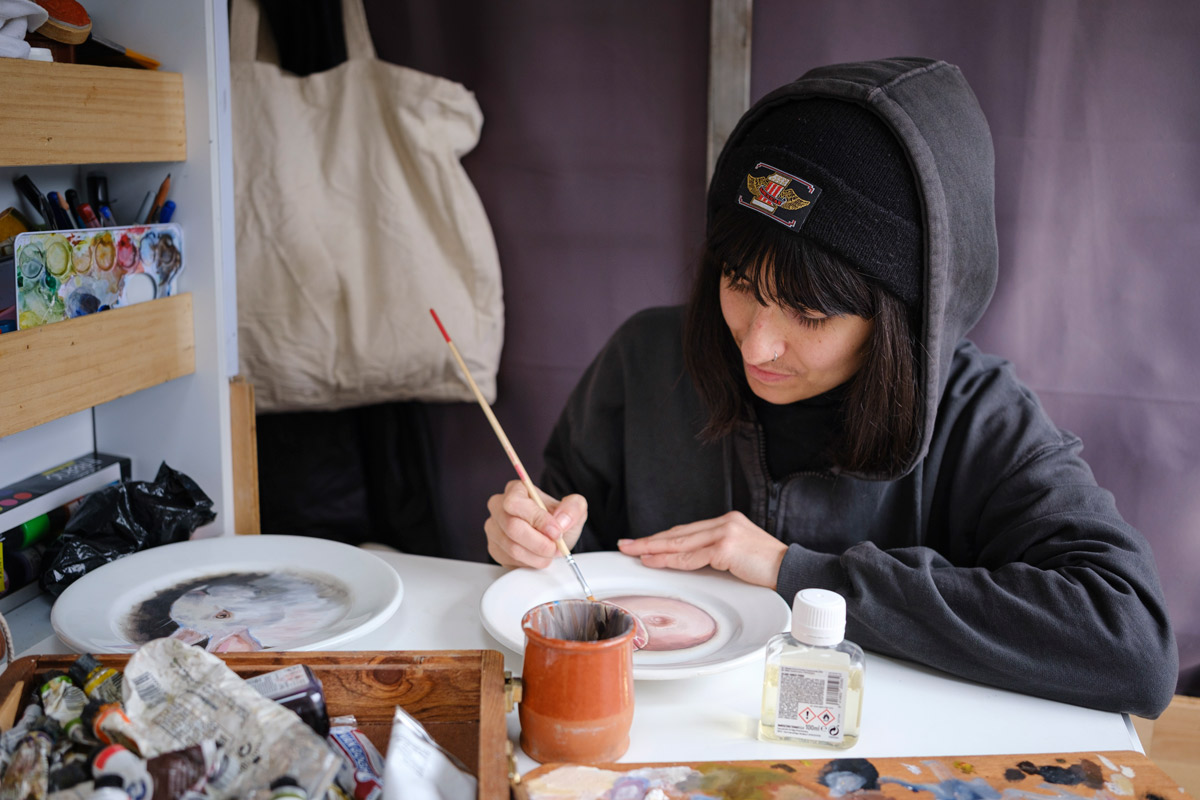“What I paint attacks the privilege we have of eating animals”
- She usually uses watercolors to communicate and abstract the painter Beatriz González and anti-specionist militants (Galdakao, 1996). At first I didn’t know what I wanted to paint because I copied what I saw, but in recent years I used art to denounce oppression against animals: “Seeing the misery of animal existence I felt I wanted to paint in favor of animal liberation.”

How did he start painting? I don't know very well when I started, but since I was a kid I liked painting. Before it was very introverted and timid: painting was not only a getaway, but a
safe space to do what it wanted. As I felt free painting, I preferred to socialize little and stay painting at home.
What did I paint? I often liked things. But six or seven years ago, I started studying academically, and I focused more on technique, on color quality -- what I did was a
mere copy of what I saw. The goal was to develop tools to create my work.
What led him to make paintings to reclaim the release of animals? Because the things I was copying didn't satisfy me, I started looking for another use. Besides benefiting me, I wanted to create an art that was beneficial to others. In the lockdown, I thought a
lot about it, because I lived with many animals rescued in an alavesa mountain. Seeing the misery of the existence of these animals, I felt like I wanted to paint in favor of animal liberation. There are many ways of being an activist and militant, and I decided to scream for art and base my struggle on anti-specialism.
"I've seen that talking to people makes me tired and I'd rather paint something and make the pictures speak."
Do you think being an anti-specialist militant influences your paintings? Of course. Six years ago, I stopped eating animals, and as I felt so lonely, I began to enter anti-specionist groups. At first I was in the Alimañas group and performed many types of activism: informative tables, performances
in the plazas and direct actions, among others. When I was in the Oihu group in Vitoria-Gasteiz, I knew more about actions directly related to art. In addition, I have seen in some way that talking to people makes me tired and I prefer to paint something and make the paintings speak.
So you say you use art as an instrument to scream? The message from my paintings is not particularly quiet, it is hard and disturbing. Many paintings
can speak, but how many scream? You notice when a painting screams; it's like when you go down the street you hear a cry you don't expect. I do not paint the pigs cheerfully, but I scream and paint with a concrete look.

In Units he painted dead pieces of animal body; in the paintings he is now creating, he has changed style. Why? Maybe I was screaming too much. Because people were very concerned, I wanted to try other techniques. Now I draw the animals in plates and cups, and I look for something more poetic. For example, the foot of a
pig and a flower next to it. It's a technique for sending the message indirectly. My goal is to bring people together and gradually decipher the message. I used to paint a dead animal.
What message do you want to send? An empathic message. I want to feel identified and put it into practice with the suffering that non-human animals feel. Induce people to that; annoy. Let's rethink how we see animals, what relationships we produce and what we feel when we see them on a
broken plate. It's a way of questioning. What's on my plate? What am I eating?
"I want to feel identified with the suffering non-human animals feel and put it into practice."
What does it achieve by sending the message indirectly? For example, in the raw The food of the
Toreros appear two ears, a cut penis and a bit of laurel very clear. With that I've made a composition, and for people, it's a headache breaker. Because it's very subtle, I don't point to people. I think we often tend to point out, and that's where we fail. It's easier to convey this message through art to a painting because people have another attitude and are willing to listen.
You've also changed the paint media. What does it add? It's a way of capturing the distance of that painting exercise and giving meaning to objects. When you see the work on a
plate, your gaze changes radically, and even more so when it's on a table. A meal is represented.
What reception do the paintings have? Since my work attacks the privilege of eating animals, I am aware that in some places I have no
place. I'm looking for alternative venues for exhibitions, where the animal theme and antispecialism is interesting, but they say it's too bloody. It's hard to walk the road, and because I want to live from art and drawing, apart from the paintings I create for activism, I also paint portraits, illustrations for stories and blinds.
For the release of animals
González has used art as a tool for communication and transformation of the world since childhood; in recent years he has focused on the altar of animal liberation: “I am an arm that has to fulfill a mission and the mission is to transform realities that I do not like”. He paints it in the van, and as a result he brings the paintings from one place to another: “When I lived in Artajona [Navarra] there were many centres that exploded pigs, the pigs occupied a lot of space in my head.” She is currently stationed in the Bilbao area.
Animalien askapenaren aldeko mugimendu antolatuaren historiaz eta garapenaz mintzo dira hamabi ekintzaile antiespezista dokumentalean. Nor taldeak sortu du lana eta ostiralean ARGIAn izango da osorik ikusgai.
I found on the ARGIA website an article with a striking title of alliance between vegans and small farmers. I was questioned and encouraged to respond to the constructive attitude of the article that is to be welcomed. There it goes.
The commercial strategies being developed... [+]























